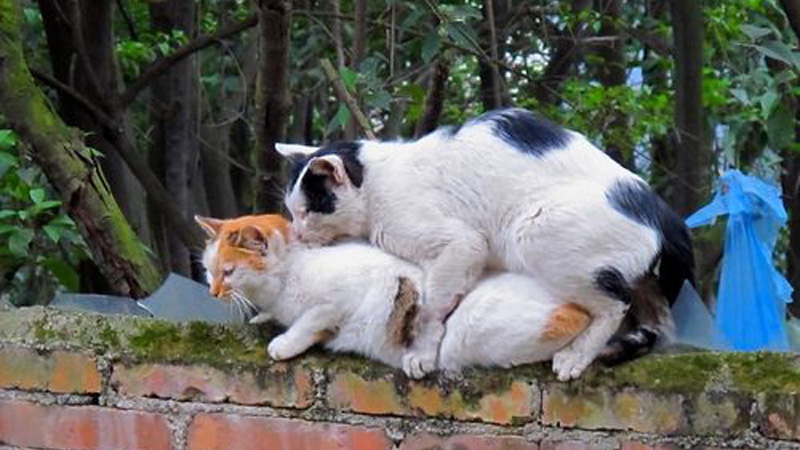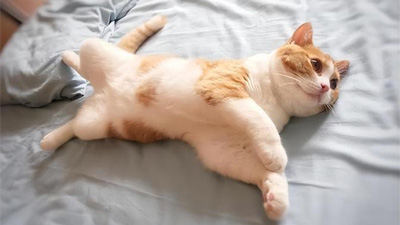Why Do Neutered Cats Still Hump?

Neutering is a common surgical procedure for male cats that involves removing the testicles to prevent reproduction. The procedure is usually done for several reasons, including controlling the cat population, reducing the risk of certain health issues, and addressing behavior problems.
One behavior that cat owners might expect to disappear after neutering is humping. However, many neutered cats still exhibit this behavior, leaving owners to wonder why they do it.
In this article, we'll explore the potential reasons why neutered cats hump and what you can do to manage the behavior.
What is Humping Behavior in Cats?
Humping is a sexual behavior common among male cats, often associated with mating. Humping behavior in a neutered cat may appear strange, unnecessary, and out of place. Despite being neutered, cats may still engage in humping behavior due to hormone influence.
Humping involves a cat mounting a person, fellow pet, or an object and thrusting its hips in a rhythmic motion. It's not limited to male cats only, since female cats also exhibit humping behavior, albeit less frequently.
Why Do Neutered Cats Still Hump?
Residual Hormones:
Hormones in the body can influence behavior. After neutering, a cat's hormone levels decrease. Although the testicles produce the majority of the hormone testosterone, a small percentage of testosterone is produced elsewhere in the body. This residual hormone may still affect the cat's behavior.
Experts suggest that cats that were sexually active before neutering may continue to engage in humping behavior due to residual hormones. The behavior may disappear after several weeks as the hormone levels reduce.
Behavioral Issues:
Stress, anxiety, and boredom are some of the reasons why cats engage in humping behavior. A neutered cat that suddenly begins to hump things may be reacting to something in the environment.
Humping behavior can also be a way for a cat to establish territories. It's not necessarily aggressive, but a way to show other cats who's boss.
Health Issues:
Some medical conditions, such as bladder infections, can cause a neutered cat to hump objects as a symptom. The pain caused by this condition may cause the cat to hump things as a way to relieve it temporarily.
This humping behavior may disappear once the health issue is treated.
Redirected Sexual Behavior:
A cat that has been neutered can no longer reproduce. However, sexual desire may still exist in the animal. This redirected sexual behavior manifests as humping behavior. It is not uncommon to find neutered cats engaging in humping behavior when they encounter an infertile cat in heat.
This redirected sexual behavior is common in cats, and it may not have any physical signs. Redirected sexual behavior may manifest as grooming, excessive meowing, and other behaviors.
How to Manage the Humping Behavior
If your neutered cat regularly engages in humping behavior, it is essential to take action to manage the behavior. The first step is consulting your veterinarian to rule out any medical conditions that may cause the behavior.
Eliminating stressors in the environment can also help. Creating a comfortable and safe space for your cat and giving them plenty of attention when they need it can reduce anxiety and stress.
Creating a regular play and exercise routine for the cat can help prevent boredom and offer an opportunity to burn excess energy. A good playtime regimen stimulates and tires the cat, reducing the likelihood of humping behavior.
Neutering the cat at the right time can also help prevent humping behavior. Neutering cats early in life can prevent them from developing humping behavior, and it can also offer other medical and behavioral benefits.
While it may be tempting to console a cat by petting them as they engage in humping behavior, it's not advisable. Doing this reinforces the behavior, meaning it is more likely to continue.
Final Thoughts
Humping behavior is common among cats, even those that have been neutered. Hedging against the behavior involves identifying the cause and finding ways to manage it.
Residual hormones, behavioral issues, health problems, and redirected sexual behavior are some of the reasons why neutered cats engage in humping behavior, depending on factors such as when they were neutered and other environmental elements.
Consulting with a veterinarian is essential in determining the cause of the humping behavior. Creating a comfortable, stress-free space can help reduce the behavior. Finally, consulting with an expert on managing cat behavior may be necessary in some cases. In conclusion, humping behavior is a common behavior that neutering does not necessarily eliminate. However, understanding the cause and addressing it creates a more comfortable space for your cat, and it spares you the confusion and stress that come with a humping cat.
You May Also Like
 Cat HealthIs Neutering Painful For Cats
Cat HealthIs Neutering Painful For Cats Help & AdviceHow Do I Care For My Cat After Neutering
Help & AdviceHow Do I Care For My Cat After Neutering Help & AdviceHow Do I Know if My Cat Needs to be Neutered?
Help & AdviceHow Do I Know if My Cat Needs to be Neutered? Cat HealthWhat Is The Best Age To Spay Or Neuter A Cat?
Cat HealthWhat Is The Best Age To Spay Or Neuter A Cat? Cat BehaviorWhy Do Male Cats Bite Blankets and Hump?
Cat BehaviorWhy Do Male Cats Bite Blankets and Hump? Breed ReviewsThe 6 Disadvantages of Male Cats, Can You Accept Them?
Breed ReviewsThe 6 Disadvantages of Male Cats, Can You Accept Them?